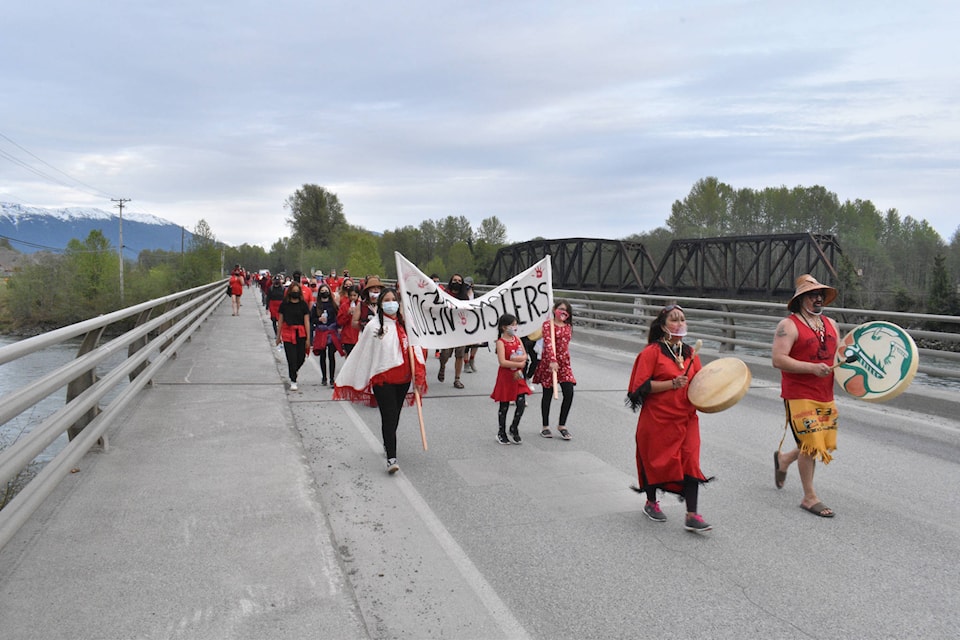“We shouldn’t have to be here still demanding awareness and recognition for our women, it should have already happened,” echoed Hilary Lightening’s voice outside Terrace City Hall on May 5 – the National Day of Awareness for Murdered & Missing Indigenous Women and Girls (MMIWG).
Lightening addressed more than five dozen people who had gathered outside the city hall to participate in a memorial march along the infamous Highway of Tears (Hwy 16) in honour of MMIWG, trans women and two-spirit people.
She was joined by longtime MMIWG advocate Gladys Radek, former Terrace councillor Jessica McCallum-Miller and Erica Davis from the Nisga’a Nation in addressing the participants.
Dressed in red clothes – which became synonymous with MMIWG after Métis artist Jamie Black’s installations – people from communities around Terrace then walked from city hall to the memorial totem pole that was erected last year at the highways ministry pullout just west of Kitsumkalum.
The event was also a call out to politicians across all levels of governments to take meaningful actions to address the issue of women’s safety.
“The government knows what they need to do, we have told them time and again for decades. We don’t need any more pomp and circumstance and empty campaign promises, we need action,” said Lightening – a member of Gitxsan First Nation.
She shared her concerns that Indigenous women like her still worry about their personal safety even today.
Lightening referred to last month’s announcement of increased cell coverage along sections of Hwy 16, calling the move a small commitment when it comes to tackling disproportionate violence against Indigenous women.
“(It is) a drop in the bucket for governments that can easily do more,” said Lightening.
She also listed projects such as the Trans Mountain pipeline and B.C. Hydro’s Site C dam as two “industrial monoliths” that the federal and provincial governments have invested that now “directly impact” the safety and lives of Indigenous women, trans women, girls and two-spirit people.
“Many of us Indigenous women know how it feels to be sexually objectified and are fearful for our safety. It is not an imaginary threat, but a very real one that shakes us to our core every time another missing persons poster circulates on the internet or worse, when a loved one goes missing or is murdered ….. we wonder, will I be next?”
The city was also called on to build the last leg of the Grand Trunk Pathway, also called the Millennium Trail, from where it stops now at Frank St. to the Kalum River Bridge just east of Kitsumkalum.
The city now has the money for the project which is in the advanced design stage prior to securing bids for construction.
“As uninvited guests and colonizers to this land, the City of Terrace can and should make these spaces safer,” said Lightening.
McCallum Miller read out the names of the Murdered & Missing Indigenous Women and Girls from RCMP’s official list.
Radek also read out the names which were not included in the official list, that she had compiled during her involvement with the National Inquiry into MMWIG as an advisor and as an advocate for families coming forward to share stories.
After Radek’s niece Tamara Chipman went missing from Prince Rupert in 2005, she started the Tears 4 Justice March walking from B.C. to Ottawa in 2008. Since then she has held numerous memorial marches for the cause.
Radek said that despite all the findings and recommendations of the commission released in June 2019, “nobody is moving on with the inquiry,” she said.
“It has stopped right at the government’s door…while our women continue to go missing,” said Radek before calling on city council to push for treatment centres and second-stage housing to further ensure the safety of women.
